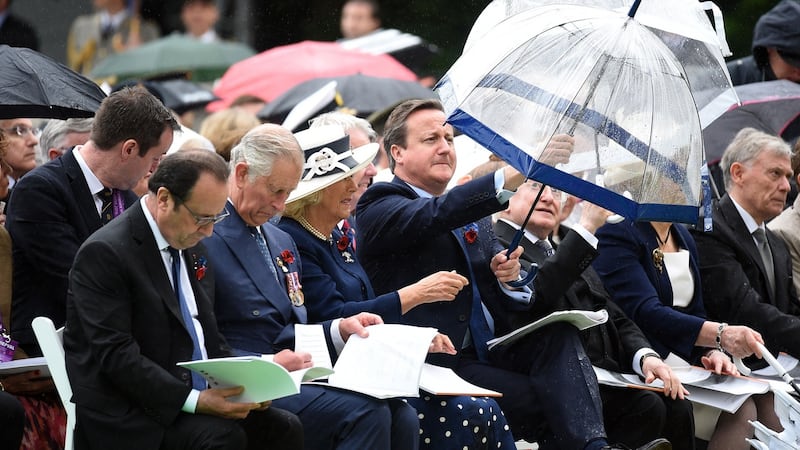The men of the 36th (Ulster) Division were remembered 100 years on in the realm of death now turned into the rolling farmlands of Picardy.
All around the Ulster Tower there are fields of wheat and in those fields are thousands of poppies put there by the hand of nature not men.
The weather on July 1st, 1916, was “heavenly”, as the poet Siegfried Sassoon remembered. It was too good in fact for the German machine-gunners who had the perfect view to cut down the Ulster men.

It was ghastly 100 years on, with heavy rain sending the 3,000 assembled guests at the tower scurrying for shelter.
As the service got under way the sun came out briefly, casting shadows across the now abundant fields of Beaumont Hamel, another abode of death where Irish men from the Inniskillings and the Royal Dublin Fusiliers were slaughtered that July day.
The Prince of Wales and his wife, the Duchess of Cornwall, First Minister of Northern Ireland Arlene Foster and Secretary of State for Northern Ireland Theresa Villiers represented the British government at the Ulster Tower.
Alan McFarland, the chairman of the Somme Association, asked those present to imagine the "sea of carnage and of devastation" that existed 100 years previously, the dead and dying lying out in no man's land while those surviving cowered in shellholes.
Ongoing
Remembrance of the Somme was ongoing, he told those present. The remains of Sgt David Harkness Blakey, who died on the first day, were only found two years ago and buried in Connaught Cemetery in Thiepval. The men had gone over the top in expectation their enemy would all be dead following a seven-day bombardment. An account by Leslie Bell of the 10th Inniskillings was read out. The men were told they could light cigarettes and pipes in no man’s land. Instead, many of his comrades were killed by a shell 30 yards from their trenches.
The service at the tower remembered a division overwhelmingly Protestant in composition. Many of those present were Orangemen for whom the visit to Thiepval Wood on July 1st was an annual pilgrimage, though not on this scale before.
One by one the wreaths piled up on the Orange Order memorial to the 36th (Ulster) Division in a garden overlooking Mill Road cemetery and the old German front line. Men from loyal Orange Orders from the North, Scotland and England queued to be photographed at the monument and pay their respects.
This was very much an affirmation of the same British identity that compelled their ancestors to walk into the teeth of the German machine guns suffering, lest we forget, more than 2,000 casualties.
Norman Potts from Shankill Road brought along his 10-year-old grandson Bailey Turkington. Mr Potts remembered his grandfather, also Norman Potts, who survived the horrors of the first day of the Battle of the Somme, and incredibly, signed up to serve in the second World War as well.
Mr Potts said there was a growing realisation in loyalist circles that Catholics too were involved. “You’d think sometimes that only men from the Shankill were involved,” he said. “If you were down in Thiepval Wood, it didn’t matter if you were a Catholic or a Protestant.”
Memory
The service reflected that no part of Ireland had a monopoly on memory or suffering on the Somme. The Government was represented by Minister for Arts
Heather Humphreys
and by chief of the Defence Forces Vice-Admiral Mark Melllett.
The Duke of Gloucester, the president of the Somme Association, told assembled guests memories of the Somme also belonged to men of the South. He alluded to the Easter Rising and how the aftermath of that rebellion had disenfranchised the memories of those men from a Catholic background and their families, but now they were being remembered too.
On the eve of commemorations for the first day of the Battle of the Somme, a production of Frank McGuinness's play Observe the Sons of Ulster Marching Towards the Somme played in Amiens. Church of Ireland Primate of All Ireland Dr Richard Clarke spoke of how in the play the Somme becomes an Ulster river like the Lagan, the Foyle or the Bann. "For many people in that province, the Somme and Ulster belongs together. This connectedness is something we celebrate today."
As the strong wind whistled through the poplar trees, he remembered the “courage, commitment , service and sacrifice” of those who died that day.




















